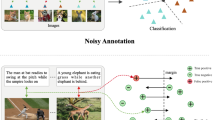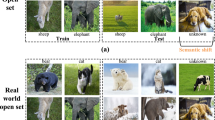Abstract
In most of the existing metric learning methods, the relation is fixed throughout the metric learning process. However, the fixed relation may be harmful to learn a good metric. The adversarial metric learning implements a dynamic update of the pairwise constraints. Inspired by the idea of dynamically updating constraints, we propose in this paper a metric learning model with clustering-based constraints (ML-CC), wherein the triple constraints of large margin are iteratively generated with the clusters of data points. The proposed method can overcome the shortage of the fixed triple constraints constructed under the Euclidian distance. The experimental results on synthetic and real datasets indicate that the performance of the ML-CC is superior to that of the existing state-of-the-art metric learning methods.





Similar content being viewed by others
References
Dong Y, Shi W, Du B, Hu X, Zhang L (2021) Asymmetric weighted logistic metric learning for hyperspectral target detection. IEEE Trans Cybern 1–14
Lv J, Kang Z, Lu X, Xu Z (2021) Pseudo-supervised deep subspace clustering. IEEE Trans Image Process 30:5252–5263
Jin Y, Li C, Li Y, Peng P, Giannopoulos GA (2021) Model latent views with multi-center metric learning for vehicle re-identification. IEEE Trans Intell Transp Syst 22(3):1919–1931
Nguyen HV, Bai L (2010) Cosine similarity metric learning for face verification. In: Asian conference on computer vision, pp 709–720
Norouzi M, Fleet DJ, Salakhutdinov RR (2012) Hamming distance metric learning. In: Advance neural information processing systems, pp 1061–1069
Xu J, Luo L, Deng C et al (2018) Multi-level metric learning via smoothed Wasserstein distance. In: Proceedings of the 27th international joint conference on artificial intelligence, pp 2919–2925
Globerson A, Roweis ST (2006) Metric learning by collapsing classes. In: Advance neural information processing systems, pp 451–458
Goldberger J, Hinton GE, Roweis ST et al (2005) Neighbourhood components analysis. In: Advance neural information processing systems, pp 513–520
Yang Z, Laaksonen J (2007) Regularized neighborhood component analysis. In: Scandinavian conference on image analysis, pp 253–262
Xing EP, Jordan MI, Russell SJ et al (2003) Distance metric learning with application to clustering with side-information. In: Advance neural information processing systems, pp 521–528
Fetaya E, Ullman S (2015). Learning local invariant mahalanobis distances. In: International conference on machine learning, pp 162–168
Wei S, Li Z, Zhang C (2017) Combined constraint-based with metric-based in semi-supervised clustering ensemble. Int J Mach Learn Cybern 9(7):1085–1100
Shuang X, Yang M, Zhou Y et al (2020) Partial label metric learning by collapsing classes. Int J Mach Learn Cybern 11(7):2453–2460
Ying Y, Li P (2012) Distance metric learning with eigenvalue optimization. J Mach Learn Res 13(1):1–26
Perrot M, Habrard A (2015). Regressive virtual metric learning. In: Advance neural information processing systems, pp 1810–1818
Zuo W, Wang F, Zhang D et al (2017) Distance metric learning via iterated support vector machines. IEEE Trans Image Process 26(10):4937–4950
Weinberger KQ, Saul LK (2009) Distance metric learning for large margin nearest neighbor classification. J Mach Learn Res 10(2):207–244
Song K, Nie F, Han J et al (2017) Parameter free large margin nearest neighbor for distance metric learning. In: Proceedings of the thirty-first AAAI conference on artificial intelligence, pp 2555–2561
Zhan D, Li M, Li Y et al (2009) Learning instance specific distances using metric propagation. In: Proceedings of the 26th annual international conference on machine learning, pp 1225–1232
Wang J, Woznica A, Kalousis A (2012) Learning neighborhoods for metric learning. In: Joint European conference on machine learning and knowledge discovery in databases, pp 223–236
Davis JV, Kulis B, Jain P et al (2007) Information-theoretic metric learning. In: Proceedings of the 24th international conference on machine learning, pp 209–216
Le Capitaine H (2018) Constraint selection in metric learning. Knowl-Based Syst 146:91–103
Wang X, Guo X, Wei W, Liang J (2021) Metric learning algorithm with adversarial sample triples constraints. CAAI Trans Intell Syst 16(1):30–37
Sui XL, Li X, Qian X et al (2018) Convex clustering with metric learning. Pattern Recogn 81:575–584
Kang Z, Lin Z, Zhu X, Xu W (2021) Structured graph learning for scalable subspace clustering: from single view to multiview. IEEE Trans Cybern
Kang Z, Pan H, Hoi SCH, Xu Z (2019) Robust graph learning from noisy data. IEEE Trans Cybern 50(5):1833–1843
Zhang L, Zhang Q, Du B, You J, Tao D (2017) Adaptive manifold regularized matrix factorization for data clustering. In: International joint conference on artificial intelligence, pp 3399–3405
Nie F, Cai G, Li X (2017) Multi-view clustering and semi-supervised classification with adaptive neighbours. Proc AAAI Conf Artif Intell 31:2408–2414
Li X, Yin H, Zhou K, Zhou X (2020) Semi-supervised clustering with deep metric learning and graph embedding. World Wide Web 23(2):781–798
Elezi I, Vascon S, Torcinovich A, Pelillo M, Leal-Taixé L (2020) The group loss for deep metric learning. In: European conference on computer vision. Springer, pp 277–294
Qi C, Zhang J, Jia H, Mao Q, Wang L, Song H (2021) Deep face clustering using residual graph convolutional network. Knowl-Based Syst 211:106561
Chen S, Gong C, Yang J et al (2018) Adversarial metric learning. In: Proceedings of the 27th international joint conference on artificial intelligence, pp 2021–2027
Acknowledgements
This work was supported by the National Natural Science Foundation of China (Nos. 61976184, 62006147, 61772323), the Projects of Key Research and Development Plan of Shanxi Province (201903D121162) and the 1331 Engineering Project of Shanxi Province, China.
Author information
Authors and Affiliations
Corresponding author
Additional information
Publisher's Note
Springer Nature remains neutral with regard to jurisdictional claims in published maps and institutional affiliations.
Rights and permissions
About this article
Cite this article
Guo, X., Dang, C., Liang, J. et al. Metric learning with clustering-based constraints. Int. J. Mach. Learn. & Cyber. 12, 3597–3605 (2021). https://doi.org/10.1007/s13042-021-01408-3
Received:
Accepted:
Published:
Issue Date:
DOI: https://doi.org/10.1007/s13042-021-01408-3




